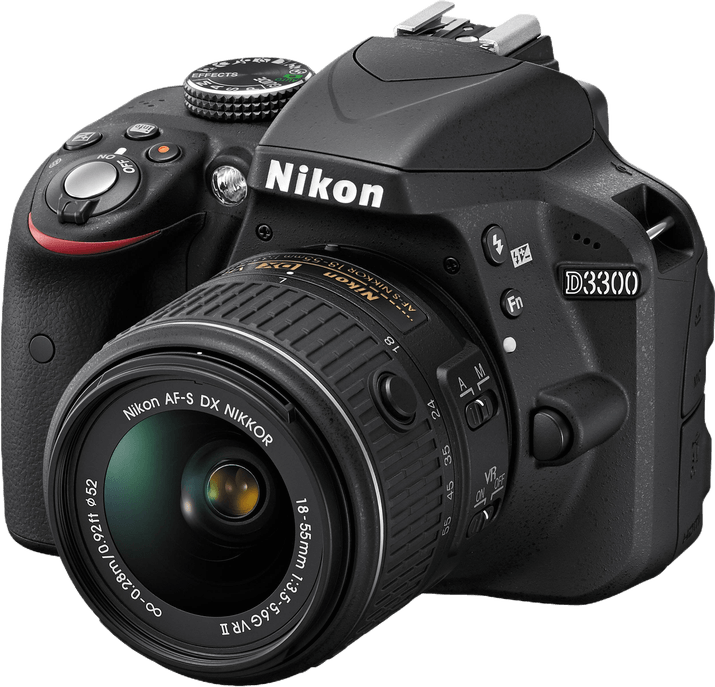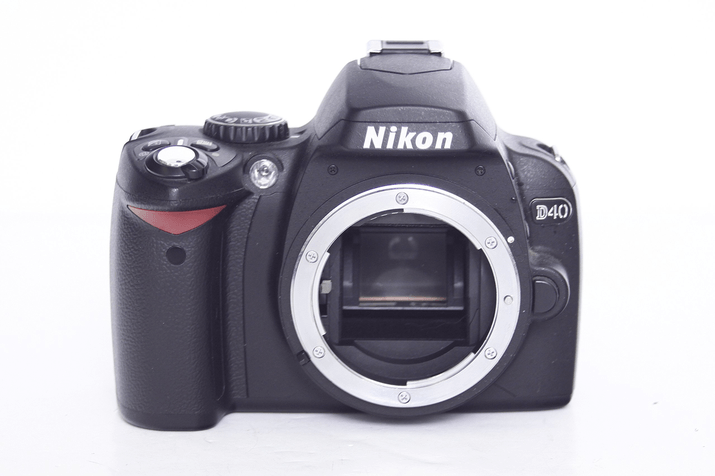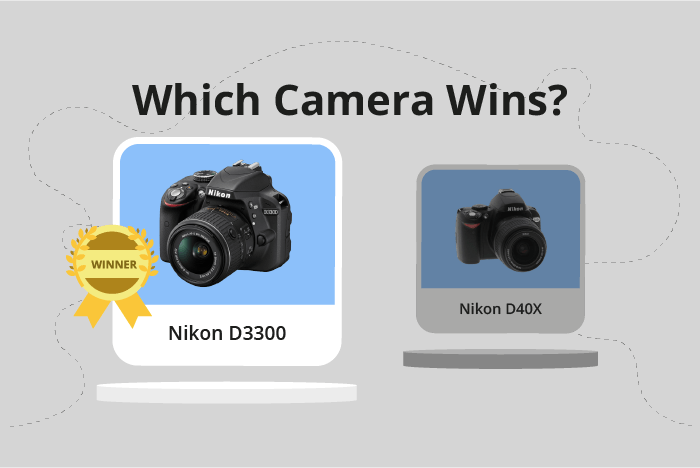Nikon D3300 vs D40X Comparison
Nikon D3300

Nikon D40X

The Nikon D3300 outperforms the Nikon D40X with a score of 55/100 compared to 33/100. Both cameras are DSLR models and share similarities in size, with the D3300 measuring 124 x 98 x 76mm and the D40X at 124 x 94 x 64mm. The D3300, released in 2014, is a more recent model than the 2007-released D40X. Priced at $650, the D3300 is also more affordable than the D40X, which launched at $998.
The D3300 excels with its lighter weight of 430g, making it more portable than the 522g D40X. However, the D40X has a slightly smaller depth, making it less bulky than the D3300. Despite this advantage, the D3300’s higher score, lower price, and lighter weight make it the superior choice between the two cameras.
Nikon D3300 vs D40X Overview and Optics
The Nikon D3300 outperforms the Nikon D40X in optics with a score of 64/100 compared to 40/100. Both cameras share some common specifications such as sensor size (APS-C), lens mount (Nikon F DX), and the absence of image stabilization.
The Nikon D3300 is superior in a few key aspects. Firstly, it offers 24.2 megapixels, which is more than double the D40X’s 10 megapixels. This allows for higher resolution images with greater detail. Additionally, the D3300 has a faster shooting speed of 5 frames per second, compared to the D40X’s 3 frames per second. This makes the D3300 better at capturing fast-moving subjects and action shots. The D3300 also uses a CMOS sensor and an Expeed 4 processor, while the D40X has a CCD sensor and an Expeed processor. These differences contribute to the D3300’s higher DXOMARK sensor score of 82, compared to the D40X’s score of 63, indicating better overall image quality.
On the other hand, the Nikon D40X does not have any specific advantages over the D3300 in terms of optics. Its lower score reflects its older technology and lesser capabilities compared to the D3300.
Taking into consideration the significant differences in megapixels, shooting speed, sensor type, processor, and DXOMARK scores, the Nikon D3300 is the clear winner in terms of optics. The Nikon D40X, while still a capable camera, falls short in comparison to the D3300’s superior specifications and performance.
Nikon D3300 vs D40X Video Performance
When comparing the Nikon D3300 and the Nikon D40X, it is essential to note that the Nikon D40X does not possess any video functionality. This lack of video recording capabilities sets the two cameras apart in terms of multimedia capabilities.
The Nikon D3300, on the other hand, offers video recording with a score of 56 out of 100. This camera allows users to record videos in Full HD quality, with a maximum resolution of 1920 x 1080 pixels. The camera supports a maximum video frame rate of 60 frames per second, providing smooth and clear footage. However, the Nikon D3300 does not come with built-in time-lapse functionality.
Taking into account that the Nikon D40X does not have video capabilities, it becomes evident that the Nikon D3300 is the more versatile camera for those who require both photography and videography options. With its Full HD video resolution and maximum frame rate of 60fps, the Nikon D3300 caters to users who need a camera that can capture both high-quality images and video footage.
Nikon D3300 vs D40X Features and Benefits
The Nikon D3300 outperforms the Nikon D40X in features, with a score of 41/100 compared to the D40X’s 17/100. Examining their similarities and differences provides insight into their strengths and weaknesses.
Both cameras lack a touchscreen, flip screen, GPS, WiFi, and Bluetooth. Their shared absence of these features reveals that neither camera excels in terms of connectivity and convenience. However, the D3300 boasts a larger screen size of 3 inches and a higher screen resolution of 921,000 dots, compared to the D40X’s 2.5-inch screen and 230,000-dot resolution. The D3300’s superior screen allows for better image preview and easier navigation through menus.
Despite their shared lack of connectivity features, the D3300 emerges as the better camera due to its larger screen and higher resolution. This advantage enhances the user experience and makes reviewing images more enjoyable. The D40X, on the other hand, does not offer any notable advantages over the D3300 in terms of features.
Considering the features of each camera, the Nikon D3300 is a superior choice due to its larger screen size and higher resolution. While the D40X may still be a functional camera, it falls short when compared to the D3300. Potential buyers should take into consideration the advantages offered by the D3300, as it provides a better user experience and improved image preview capabilities.
Nikon D3300 vs D40X Storage and Battery
The Nikon D3300 outperforms the Nikon D40X in storage and battery with a score of 32/100 compared to the D40X’s 27/100. Both cameras share some common specifications, including a single memory card slot and no USB charging capability. They both accept SD and SDHC memory cards, but the D3300 also supports SDXC cards, giving it an edge in storage capacity.
In terms of battery life, the D3300 lasts for 700 shots, which is significantly longer than the D40X’s 520 shots. The D3300 uses the EN-EL14a battery type, while the D40X employs the EN-EL9 battery. This difference contributes to the D3300’s superior battery performance.
However, the D40X does not have any significant advantages in storage and battery over the D3300. With a longer battery life and support for SDXC memory cards, the D3300 is the clear winner in this category. The D40X’s lower score reflects its limitations in comparison to the D3300.
Nikon D3300 vs D40X – Our Verdict
Are you still undecided about which camera is right for you? Have a look at these popular comparisons that feature the Nikon D3300 or the Nikon D40X:

